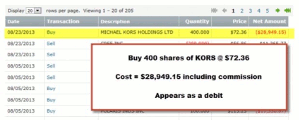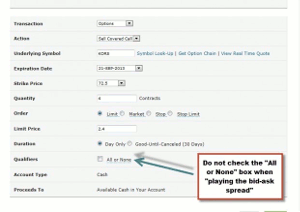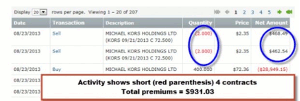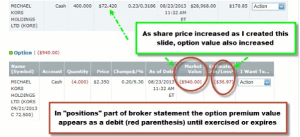Executing a covered call trade and understanding the accounting procedures on our broker statements can be confusing to the new option trader, writes Alan Ellman of TheBlueCollarInvestor.com.
I have recently received a few emails regarding this topic so I thought it would be useful to show an actual trade I made with Michael Kors Holdings (KORS). The four steps we will review are:
- Purchase 400 Shares of KORS
- Confirm Purchase
- Sell 4 September Call Contracts
- Confirm Sale
Entering a covered call trade in this manner is known as legging-in.
Steps 1 and 2
Since the bid-ask spread is tight (small difference between the bidand the ask), I placed a market order to purchase 400 shares and got executed @ $72.36:

Confirmed purchase of 400 x KORS @ $72.36
Click to Enlarge
Note that the total cost, including commissions is $28,949.15 and appears as a debit (red parenthesis). This appears in the “Activities” section of the brokerage statement.
Step 3
Now that I own the shares and I’m in a covered or protected position, I am free to sell the call option. I decided to sell the near-the-money $72.50 September call option, slightly less than 1-month to contract expiration. Here is the trade execution form:

Selling a covered call option for KORS
Click to Enlarge
Please note the following:
- The first six lines are self-explanatory
- We enter a limit order, not a market order
- We enter a limit price based on the bid-ask spread shown in an options chain
- The order is day only
***DO NOT CHECK THE ALL OR NONE BOX when playing the bid-ask spread.
Step 4
Next, I checked the activity section of the broker statement (order status can also be checked) to see if the option sale was executed:

4 Sept. $72.50 calls sold for KORS
Click to Enlarge
Please note:
- Four contracts were confirmed sold for a total of $931.03, including commissions
- My initial one-month return is $931.03/$28,949.15 = 3.2%, 1-month return, after commissions
- Notice the option price dropped from $2.40 to $2.35 while I was creating these slides (took one for the team!)
- The contracts appear in red parenthesis because I am short these contracts (I sold them and have an obligation)
- Since I am long the shares, they appear in black and NOT in parenthesis
Positions section of brokerage statement
This is the section that can get quite confusing. Although I generated $931 in cash from the sale of the four contracts, the option value will appear as a debit in this portion of the statement because the position is still open and may have to be bought back. Let’s have a look a couple of minutes after the trade was executed:

KORS: stock and options positions
Click to Enlarge
Please note:
- As share value started to rise after the trade was executed so did the value of the option premium.
- Option value appears as a debit (red) because the cost to buy back is greater than the premium received.
- This is deceiving because an increase in share value is a positive for us. This is simply an accounting technique used by brokerages, which we must understand.
- The four contracts also appear in red because I am short these contracts and still hold an options obligation.
- The cash generated from the sale of the options IS in the cash portion of my account and available to trade with.
- Once the options expire or are bought back or exercised the apparent debits and short positions are deleted from the positions section of the broker statement. The cash, of course, is ours to keep.
Conclusion
Brokerage statements will not all appear precisely the same but will be similar in many respects. When executing our covered call trades, it is important to be aware of the accounting methods used by our respective brokers to avoid confusion. Be sure to fully understand your broker’s platform before entering your first covered call trade.
By Alan Ellman of TheBlueCollarInvestor.com





















